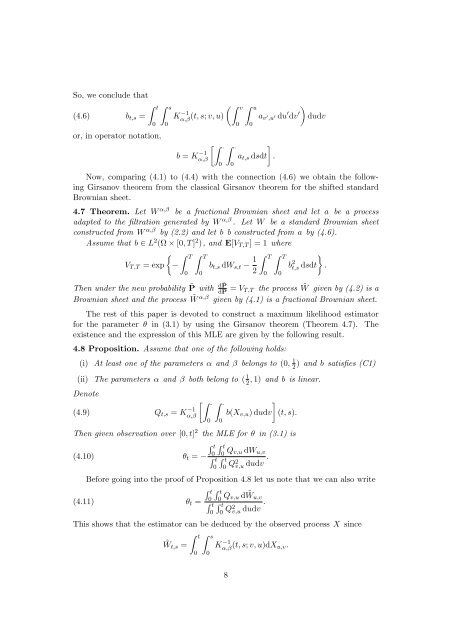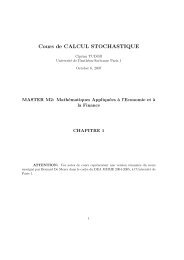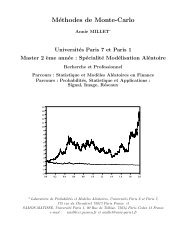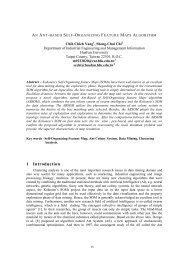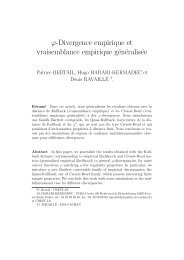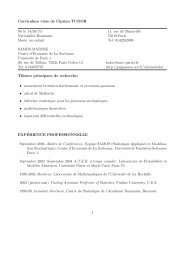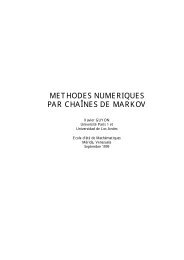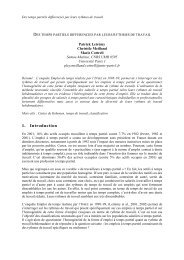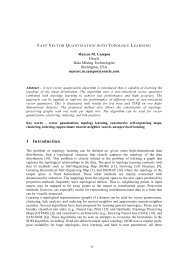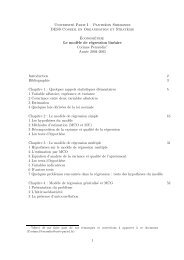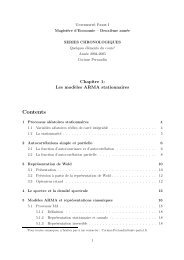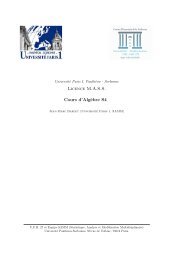Parameter estimation for stochastic equations with ... - samos-matisse
Parameter estimation for stochastic equations with ... - samos-matisse
Parameter estimation for stochastic equations with ... - samos-matisse
You also want an ePaper? Increase the reach of your titles
YUMPU automatically turns print PDFs into web optimized ePapers that Google loves.
So, we conclude that<br />
(4.6) b t,s =<br />
∫ t ∫ s<br />
or, in operator notation,<br />
0<br />
0<br />
K −1<br />
α,β (t, s; v, u) (∫ v<br />
b = K −1<br />
α,β<br />
[∫ ·<br />
0<br />
∫ ·<br />
0<br />
0<br />
∫ u<br />
0<br />
]<br />
a t,s dsdt .<br />
a v ′ ,u ′ du′ dv ′ )<br />
dudv<br />
Now, comparing (4.1) to (4.4) <strong>with</strong> the connection (4.6) we obtain the following<br />
Girsanov theorem from the classical Girsanov theorem <strong>for</strong> the shifted standard<br />
Brownian sheet.<br />
4.7 Theorem. Let W α,β be a fractional Brownian sheet and let a be a process<br />
adapted to the filtration generated by W α,β . Let W be a standard Brownian sheet<br />
constructed from W α,β by (2.2) and let b b constructed from a by (4.6).<br />
Assume that b ∈ L 2 (Ω × [0, T ] 2 ), and E[V T,T ] = 1 where<br />
{ ∫ T ∫ T<br />
V T,T = exp − b t,s dW s,t − 1 ∫ T ∫ T<br />
}<br />
b 2 t,s dsdt .<br />
2<br />
0<br />
0<br />
Then under the new probability ˜P <strong>with</strong> d ˜P<br />
dP = V T,T the process ˜W given by (4.2) is a<br />
Brownian sheet and the process ˜W α,β given by (4.1) is a fractional Brownian sheet.<br />
The rest of this paper is devoted to construct a maximum likelihood estimator<br />
<strong>for</strong> the parameter θ in (3.1) by using the Girsanov theorem (Theorem 4.7). The<br />
existence and the expression of this MLE are given by the following result.<br />
4.8 Proposition. Assume that one of the following holds:<br />
(i) At least one of the parameters α and β belongs to (0, 1 2<br />
) and b satisfies (C1)<br />
(ii) The parameters α and β both belong to ( 1 2<br />
, 1) and b is linear.<br />
Denote<br />
(4.9) Q t,s = K −1<br />
α,β<br />
[∫ ·<br />
0<br />
∫ ·<br />
0<br />
]<br />
b(X v,u ) dudv (t, s).<br />
Then given observation over [0, t] 2 the MLE <strong>for</strong> θ in (3.1) is<br />
(4.10) θ t = −<br />
∫ t ∫ t<br />
0<br />
∫ t<br />
0<br />
0<br />
0 Q v,u dW u,v<br />
∫ t<br />
0 Q2 v,u dudv .<br />
Be<strong>for</strong>e going into the proof of Proposition 4.8 let us note that we can also write<br />
(4.11) θ t =<br />
∫ t ∫ t<br />
0<br />
∫ t<br />
0<br />
0 Q v,u d ˜W u,v<br />
∫ t<br />
0 Q2 v,u dudv .<br />
This shows that the estimator can be deduced by the observed process X since<br />
˜W t,s =<br />
∫ t ∫ s<br />
0<br />
0<br />
K −1<br />
α,β (t, s; v, u)dX u,v.<br />
0<br />
8


